Aplanatic and achromatic lenses are common multielement designs that are similar in many ways, but their differences are crucial.
Emily Kubacki, CVI Laser LLC
Optics terminology can be confusing, but it is critical to be fluent in the language when searching for and specifying optical components. This is especially true for multielement lenses, the two most basic of which are aplanats and achromats.
Both typically consist of two or three lens elements, respectively referred to as doublets or triplets. However, they are distinct types of lenses with different applications and different design criteria. Trying to substitute one for the other based solely on price or availability could produce disturbing results.
Aplanats
An aplanatic lens is designed to minimize two monochromatic wavefront errors, called spherical aberration and coma. Spherical aberration is axially symmetric and occurs when rays from a point on the axis passing through the outer zones of the lens focus at a different distance from the lens than rays passing through the central zone. Coma is an off-axis, asymmetric wavefront distortion that increases linearly with field angle or distance from the principal axis.
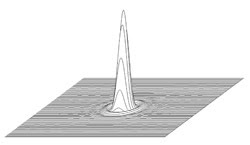
This point-spread function depicts a diffraction-limited lens.
Together, these aberrations distort the transmitted wavefront through the lens and cause the focal spot to become irregularly shaped, blurred or both.
Often called Fraunhofer lenses, after the 19th-century optician and physicist Joseph von Fraunhofer, aplanats are used as microscope objective lenses and condenser lenses. In applications such as laser beam delivery systems, microchip production and narrowband materials processing, tight control of the resulting image and/or focal spot size is critical to system performance and functionality.
Depending on the design criteria, doublet and triplet aplanatic lens designs can employ one substrate material or different materials. They are optimized for a single wavelength and usually are air-spaced to eliminate additional wavefront distortion from cement between the glass surfaces. Air-spacing the elements also allows for increased flexibility in design because adjacent surfaces do not have to have matching curvatures. Instead, each of the four to six surfaces can be optimized independently. The air spaces thus can be treated as additional lens elements to better reduce coma and spherical aberration through the assembly.
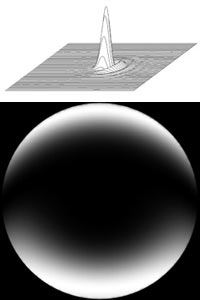
Uncorrected coma leads to irregularly shaped focus spots or a change in magnification with field angle. The top figure is the point-spread function of a lens with coma; the bottom figure is a near-focus interferogram of the same lens design.
Although the original Fraunhofer doublet was designed with a narrow air gap, other designs use a wide gap, a narrow gap with the edges of the lenses touching (called a contact doublet) or a bonded assembly. The benefits of a bonded assembly are increased mechanical strength, durability and overall transmission as a result of fewer reflections produced by external surfaces.
Aplanatic lenses designed with only UV or excimer grades of fused silica glass are commonly used as focusing lenses for excimer lasers, but they also are suitable for high-energy, 1064-nm Nd:YAG beam steering applications. An amorphous form of silicon dioxide, fused silica glass has very high laser damage thresholds as well as high transmittance throughout the UV, visible and near-infrared wavelength regions. With high-energy antireflection coatings applied, an air-spaced fused silica doublet lens will transmit greater than 98 to 99 percent of the incoming light while still withstanding more than 30 J/cm2 of pulsed radiation at 1064 nm.
Achromats
Achromatic lenses are designed for broadband applications, including astronomy, color photomicrography, plasma spectroscopy and biomedical instrumentation. They consist of two or more lens elements that are composed of discrete glass materials and corrected for chromatic aberration with respect to two wavelengths, normally blue and red.
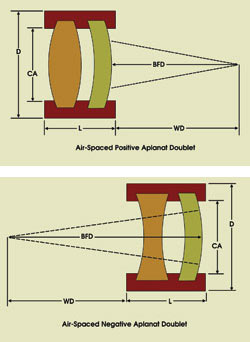
Positive and negative aplanatic doublets are corrected for spherical and coma aberrations. Aplanats are made of SF11 and/or UV-grade fused silica. D = diameter; CA = clear aperture; BFD = back focal distance; L = length; WD = working distance.
Chromatic aberration is produced by dispersion, or the variation of a material’s refractive index with wavelength, and causes different wavelengths to have different focal points. By using separate substrate materials such as crown glass and flint glass for the converging (positive) and diverging (negative) lens elements, the dispersion of each can be compensated for by the other, minimizing the total effect. Whether the overall lens assembly is converging or diverging depends on which lens element has the greater power. In a typical achromat, the positive element is constructed from crown glass and is planoconvex or biconvex, and the negative element is made of flint glass and is a meniscus.
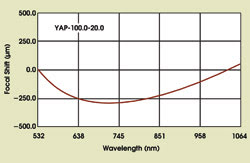
This focal shift plot shows that this achromat designed for use with 532 and 1064 nm has the same focal point at those wavelengths. It also shows how far from ideal the lens would perform if used with other than the design wavelengths.
Color correction
In imaging and precision micromachining, it is often crucial that the secondary spectrum or a third wavelength be color-corrected in addition to the blue (F-line) and red (C-line). An apochromatic lens that minimizes both spherical and chromatic aberration at three wavelengths accomplishes this. Apochromats are more expensive than achromats because they typically are made from more exotic glass materials, which cost more and which are more difficult to process than standard crown and flint glasses.
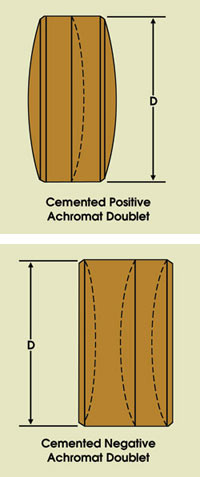
Positive and negative achromatic doublets correct for chromatic aberrations, which are problematic in multiwavelength applications.
Depending on the application, doublet and triplet achromatic lens designs can be optimized for broad wavelength regions (usually in the visible from 400 to 700 nm) or for two distinct wavelengths (such as 1064 or 532 nm). For dual-wavelength beam-steering applications, the use of a visible HeNe or doubled Nd:YAG laser beam that follows the same optical path makes it easier to align near-IR lasers and diodes.
Although achromatic doublets usually are cemented, they can be air-spaced to increase their damage threshold and to reduce wavefront distortion transmitted through the assembly. As with aplanats, air-spacing the components allows for more flexibility in the design, which in turn leads to even better color correction. Because they are not symmetric in either design or function, however, achromats exhibit significant wavefront distortions if not oriented correctly.
Neither crown nor flint glasses transmit well below 420 nm, so other materials are required for applications with broadband or multiwavelength UV sources. Because of limitations in UV-transmitting materials, however, few options are available to optical designers. Existing designs use fused silica glass for the positive element and either UV-grade calcium fluoride or lithium fluoride for the negative. An achromat comprising either of these combinations can be optimized for a 200-nm bandwidth centered around 300 or 350 nm, depending on the application requirements.
UV achromats are ideally suited to broadband UV applications such as photometric instrumentation and fluorescence analysis. However, in some situations they can be used as focusing lenses in place of aplanats. For example, most commercially available UV aplanats are designed for 248 nm. At other wavelengths, such as 365 nm (I-line) and 405 nm (H-line) from laser diodes used in lithography exposure systems, more precise focal lengths may result from an achromat.
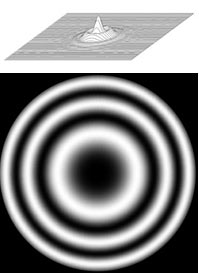
Uncorrected spherical aberrations lead to blurry images or focal spots. The top figure depicts the point-spread function of a lens with spherical aberration at marginal focus; the bottom figure is an interferogram of the same lens design.
Lens pointers
Aplanatic lenses are designed to produce the minimum focal spot size at a particular wavelength by eliminating coma and spherical aberrations. They are usually air-spaced and can have two, three or four lens elements made from one or more glass materials. In contrast, achromatic lenses can be cemented or air-spaced, are used for multiple wavelengths and must be made from at least two types of glass. Achromats and apochromats can be corrected for other variations besides chromatic aberration, but they primarily are intended to focus two or three wavelengths at the same point in the image plane.
Meet the author
Emily Kubacki is a senior optical engineer in the sales department and product manager for optical components at CVI Laser LLC in Albuquerque, N.M.; e-mail: [email protected].